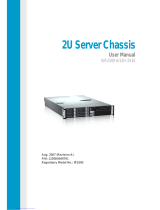
Installing a drive into the drive carrier....................................................................................................................44
Backplane cover................................................................................................................................................................ 45
Removing the backplane cover................................................................................................................................45
Installing the backplane cover.................................................................................................................................. 46
Inside the system...............................................................................................................................................................47
Air shroud............................................................................................................................................................................50
Removing the air shroud............................................................................................................................................50
Installing the air shroud..............................................................................................................................................50
Cooling fans.........................................................................................................................................................................51
Removing a cooling fan...............................................................................................................................................51
Installing a cooling fan................................................................................................................................................ 52
System memory................................................................................................................................................................. 53
System memory guidelines........................................................................................................................................53
General memory module installation guidelines....................................................................................................54
NVDIMM-N memory module installation guidelines ...........................................................................................55
DCPMM installation guidelines ............................................................................................................................... 59
Mode-specific guidelines........................................................................................................................................... 60
Removing a memory module.....................................................................................................................................63
Installing a memory module.......................................................................................................................................64
NVDIMM-N battery.......................................................................................................................................................... 65
Removing the NVDIMM-N battery......................................................................................................................... 65
Installing the NVDIMM-N battery........................................................................................................................... 66
Processors and heat sinks...............................................................................................................................................67
Removing a processor and heat sink module........................................................................................................67
Removing the processor from the processor and heat sink module.............................................................. 68
Installing the processor into a processor and heat sink module...................................................................... 69
Installing a processor and heat sink module...........................................................................................................71
Expansion cards and expansion card risers.................................................................................................................72
Expansion bus specifications.................................................................................................................................... 72
Removing an expansion card riser........................................................................................................................... 77
Installing an expansion card riser............................................................................................................................. 79
Removing expansion card from the expansion card riser...................................................................................81
Installing an expansion card into expansion card riser........................................................................................84
M.2 SSD module................................................................................................................................................................ 86
Removing the M.2 SSD module............................................................................................................................... 86
Installing the M.2 SSD module..................................................................................................................................87
Optional IDSDM or vFlash module................................................................................................................................ 88
Removing the optional IDSDM or vFlash card......................................................................................................88
Installing optional IDSDM or vFlash card............................................................................................................... 89
Optional IDSDM or vFlash module................................................................................................................................ 90
Removing the MicroSD card.....................................................................................................................................90
Installing the MicroSD card........................................................................................................................................91
Network daughter card....................................................................................................................................................92
Removing the network daughter card....................................................................................................................92
Installing the network daughter card......................................................................................................................93
Integrated storage controller card................................................................................................................................ 94
Removing the integrated storage controller card............................................................................................... 94
Installing the integrated storage controller card................................................................................................. 95
Backplane............................................................................................................................................................................ 97
Backplane details......................................................................................................................................................... 97
4
Contents
























